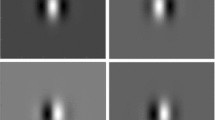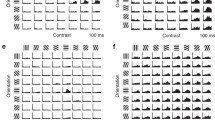Abstract
The inhomogeneous distribution of the receptive fields of cortical neurons influences the cortical representation of the orientation of short lines seen in visual images. We construct a model of the response of populations of neurons in the human primary visual cortex by combining realistic response properties of individual neurons and cortical maps of orientation and location preferences. The encoding error, which characterizes the difference between the parameters of a visual stimulus and their cortical representation, is calculated using Fisher information as the square root of the variance of a statistically efficient estimator. The error of encoding orientation varies considerably with the location and orientation of the short line stimulus as modulated by the underlying orientation preference map. The average encoding error depends only weakly on the structure of the orientation preference map and is much smaller than the human error of estimating orientation measured psychophysically. From this comparison we conclude that the actual mechanism of orientation perception does not make efficient use of all the information available in the neuronal responses and that it is the decoding of visual information from neuronal responses that limits psychophysical performance.
Similar content being viewed by others
References
Blasdel G, Campbell D (2001) Functional retinotopy of monkey visual cortex. J. Neurosci.: The Official J. Soc. Neurosci. 21(20): 8286–8301.
Blasdel G (1992) Orientation selectivity, preference, and continuity in monkey striate cortex. J. Neurosci. : The Official J. Soc. Neurosci. 12(8): 3139–3161.
Bosking WH, Crowley JC, Fitzpatrick D (2002) Spatial coding of position and orientation in primary visual cortex. Nature Neurosci. 5(9): 874–882.
Brunel N, Nadal JP (1998) Mutual information, fisher information, and population coding. Neurosci. Comput. 10(7): 1731–1757.
Callaway EM (1998) Local circuits in primary visual cortex of the macaque monkey. Ann. Rev. Neurosci. 21: 47–74.
Cover TM, Thomas JA (1991) Elements of Information Theory. Wiley, New York, p. 542.
Das A, Gilbert CD (1997) Distortions of visuotopic map match orientation singularities in primary visual cortex. Nature 387(6633): 594–598.
DeAngelis GC, Freeman RD, Ohzawa I (1994) Length and width tuning of neurons in the cat’s primary visual cortex. J. Neurophysiol. 71(1): 347–374.
DeAngelis GC, Ghose GM, Ohzawa I, Freeman RD (1999) Functional micro-organization of primary visual cortex: Receptive field analysis of nearby neurons. J. Neurosci. : The Official J. Soc. Neurosci. 19(10): 4046–4064.
Dougherty RF, Koch VM, Brewer AA, Fischer B, Modersitzki J, Wandell BA (2003) Visual field representations and locations of visual areas V1/2/3 in human visual cortex. J. Vis. 3(10): 586–598.
Duncan RO, Boynton GM (2003) Cortical magnification within human primary visual cortex correlates with acuity thresholds. Neuron 38(4): 659–671.
Eurich CW, Wilke SD (2000) Multidimensional encoding strategy of spiking neurons. Neural Comput. 12(7): 1519–1529.
Gershon ED, Wiener MC, Lathamut PE, Richmond BJ (1998) Coding strategies in monkey V1 and inferior temporal cortices. J. Neur. 79(3): 1135–1144.
Haynes JD, Rees G (2005) Predicting the orientation of invisible stimuli from activity in human primary visual cortex. Nature Neurosci. 8(5): 686–691.
Hubel DH, Wiesel TN (1977) Ferrier lecture. functional architecture of macaque monkey visual cortex. Proc. Royal Soc. of London, Series B. Biolog. Sci. 198(1130): 1–59.
Hubel DH, Wiesel TN (1974) Uniformity of monkey striate cortex: A parallel relationship between field size, scatter, and magnification factor. J. Comp. Neurol. 158(3): 295–305.
Itti L, Koch C, Braun J (1999) A quantitative model relating visual neuronal activity to psychophysical thresholds. Neurocomputing 26–27: 743–748.
Kamitani Y, Tong F (2005) Decoding the visual and subjective contents of the human brain. Nature Neurosci. 8(5): 679–685.
Kapadia MK, Westheimer G, Gilbert CD (2000) Spatial distribution of contextual interactions in primary visual cortex and in visual perception. J. Neurophysiol. 84(4): 2048–2062.
Kjaer TW, Gawne TJ, Hertz JA, Richmond BJ (1997) Insensitivity of V1 complex cell responses to small shifts in the retinal image of complex patterns. J. Neurophysiol. 78(6): 3187–3197.
Lehky SR, Sejnowski TJ, Desimone R (2005) Selectivity and sparseness in the responses of striate complex cells. Vis. Res. 45(1): 57–73.
Lund JS, Angelucci A, Bressloff PC (2003) Anatomical substrates for functional columns in macaque monkey primary visual cortex. Cerebral Cortex 13(1): 15–24.
Mountcastle VB (1997) The columnar organization of the neocortex. Brain; J. Neurol. 120(Pt 4): 701–722.
Ott D, Seidman SH, Leigh RJ (1992) The stability of human eye orientation during visual fixation. Neur. Lett. 17,142(2): 183–186.
Paradiso MA (1988) A theory for the use of visual orientation information which exploits the columnar structure of striate cortex. Biolog. Cybern. 58(1): 35–49.
Paradiso MA, Carney T (1988) Orientation discrimination as a function of stimulus eccentricity and size: Nasal/temporal retinal asymmetry. Vis. Res. 28(8): 867–874.
Pouget A, Dayan P, Zemel RS (2003) Inference and computation with population codes. Ann. Rev. Neurosci. 26: 381–410.
Ringach DL, Shapley RM, Hawken MJ (2002) Orientation selectivity in macaque V1: Diversity and laminar dependence. The Journal Neurosci.: The Official J. Soc. Neurosci. 22(13): 5639–5651.
Sceniak MP, Hawken MJ, Shapley R (2001) Visual spatial characterization of macaque V1 neurons. J. Neurophys. 85(5): 1873–1887.
Series P, Latham PE, Pouget A (2004) Tuning curve sharpening for orientation selectivity: Coding efficiency and the impact of correlations. Nature Neurosci. 7(10): 1129–1135.
Seung HS, Sompolinsky H (1993) Simple models for reading neuronal population codes. Proc. Nat. Acad. Sci. USA 90(22): 10749–10753.
Shadlen MN, Britten KH, Newsome WT, Movshon JA (1996) A computational analysis of the relationship between neuronal and behavioral responses to visual motion. J. Neurosci. : The Official J. Soc. Neurosci. 16(4): 1486–1510.
Softky WR, Koch C (1993) The highly irregular firing of cortical cells is inconsistent with temporal integration of random EPSPs. J. Neurosci.: The Official J. Soc. Neurosci. 13(1): 334–350.
Spitzer H, Hochstein S (1988) Complex-cell receptive field models. Progr. Neurobiol. 31(4): 285–309.
Stevens CF (2001) An evolutionary scaling law for the primate visual system and its basis in cortical function. Nature 411(6834): 193–195.
Swindale NV (1998) Orientation tuning curves: Empirical description and estimation of parameters. Biolog. Cybern. 78(1): 45–56.
Swindale NV, Shoham D, Grinvald A, Bonhoeffer T, Hubener M (2000) Visual cortex maps are optimized for uniform coverage. Nature Neurosci. 3(8): 822–826.
Tolhurst DJ, Ling L (1988) Magnification factors and the organization of the human striate cortex. Human Neurobiol. 6(4): 247–254.
Tolhurst DJ, Movshon JA, Dean AF (1983) The statistical reliability of signals in single neurons in cat and monkey visual cortex. Vis. Res. 23(8): 775–785.
Touryan J, Felsen G, Dan Y (2005) Spatial structure of complex cell receptive fields measured with natural images. Neuron 45(5): 781–791.
Van Essen DC, Newsome WT, Maunsell JH (1984) The visual field representation in striate cortex of the macaque monkey: Asymmetries, anisotropies, and individual variability. Vis. Res. 24(5): 429–448.
Vandenbussche E, Vogels R, Orban GA (1986) Human orientation discrimination: Changes with eccentricity in normal and amblyopic vision. Invest. Ophthalmol. Vis. Sci. 27(2): 237–245.
Vanduffel W, Tootell RB, Schoups AA, Orban GA (2002) The organization of orientation selectivity throughout macaque visual cortex. Cerebral Cortex (New York, NY, 1991) 12(6): 647–662.
Westheimer G (2003) The distribution of preferred orientations in the peripheral visual field. Vis. Res. 43(1): 53–57.
Wiener MC, Richmond BJ (2002) Model based decoding of spike trains. Bio. Syst. 67(1–3): 295–300.
Wiener MC, Oram MW, Liu Z, Richmond BJ (2001) Consistency of encoding in monkey visual cortex. J. Neurosci.: The Official J. Soc. Neurosci. 21(20): 8210–8221.
Wilke SD, Eurich CW (2002) Representational accuracy of stochastic neural populations. Neural Comp. 14(1): 155–189.
Zanker JM, Braitenberg V (1996) Psychophysical mapping of orientation sensitivity in the human cortex. In A Aertsen, V Braitenberg, eds. Brain Theory: Biological Basis and Computational Principles. Elsevier, Amsterdam, New York, p. 1
Zhang K, Sejnowski TJ (1999) Neuronal tuning: To sharpen or broaden? Neural Comput. 11(1): 75–84.
Zohary E (1992) Population coding of visual stimuli by cortical neurons tuned to more than one dimension. Biolog. Cybern. 66(3): 265–272.
Author information
Authors and Affiliations
Corresponding author
Additional information
Action Editor: Terrence Sejnowski
Rights and permissions
About this article
Cite this article
Shokhirev, K.N., Kumar, T. & Glaser, D.A. The influence of cortical feature maps on the encoding of the orientation of a short line. J Comput Neurosci 20, 285–297 (2006). https://doi.org/10.1007/s10827-006-6485-7
Received:
Revised:
Accepted:
Published:
Issue Date:
DOI: https://doi.org/10.1007/s10827-006-6485-7




